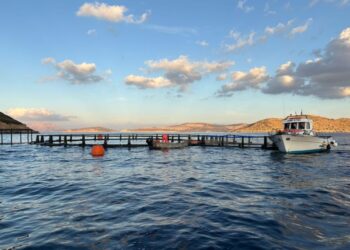The potential of lupins to make a difference in the future of fish nutrition to achieve a sustainable aquaculture – As the aquaculture industry faces the challenge of finding cost-effective and environmentally friendly feed solutions, one promising alternative has emerged – lupine (Lupinus spp.). This versatile legume has garnered increasing attention for its nutritional value and potential to revolutionize the way we approach aquafeed formulations.
A team of researchers from the Tamil Nadu Dr. J. Jayalalithaa Fisheries University (India) published a scientific review exploring the potential of lupine in the aquaculture industry, focusing on its nutritional value, digestibility, and impact on the health and growth of fish.
The researchers also analyze recent findings, challenges, and possible advancements to provide insights into how lupine could drive the development of sustainable aquaculture techniques.
Lupine, a versatile legume grown in various regions, is rich in protein and has a balanced profile of essential amino acids crucial for the optimal growth and development of fish.
Moreover, research has indicated that the inclusion of lupine in fish diets can positively affect fish health, potentially improving their immune response and overall well-being.
The study reports the following benefits of including lupine in aquafeeds:
Lupine Digestibility: The protein digestibility of lupine in fish such as salmon and trout (85.2%) is higher than that of whole soybean meal (79.5%).
Nutritional Deficiencies: Lupine, as a plant source, lacks essential amino acids such as methionine and lysine, resulting in reduced growth when used in high inclusions (40%).
Antinutritional Factors: The presence of non-starch polysaccharides, oligosaccharides, and antinutritional factors in lupine can contribute to reduced growth in salmon.
Optimal Inclusion
In rainbow trout, a 25% substitution of fishmeal with lupine improves growth and feed acceptance.
In Atlantic salmon, a partial lupine inclusion between 20% and 40% is recommended.
Carp: For common carp, a partial substitution of 12.5% soybean meal with lupine seed meal improves weight gain and feed efficiency. In black carp, a 30% substitution shows similar results.
Seabass: A dietary inclusion of lupine seed meal between 40% and 50%, with proper processing techniques, enhances growth.
Tilapia: A dietary inclusion of up to 50% produces high growth.
Turbot: A 50% inclusion enhances growth.
Cobia: A dietary inclusion of 10.5% provides growth comparable to that of fishmeal.
Shrimp: In black tiger shrimp (Penaeus monodon), lupine seed meal can replace up to 40-50% of soybean meal. In white shrimp (Litopenaeus vannamei), a 10% inclusion (100 g/kg) provides better growth compared to 20% or 30% inclusions.
Nutritional Profile and Digestibility
Lupine is a rich source of protein, boasting a crude protein (33 to 43 g), crude lipids (6 to 11 g), and ash content (2.9 to 4.6), makes it an attractive substitute for fishmeal for aquafeed manufacturers, which has traditionally been the most used protein source in aquaculture. Its balanced profile of essential amino acids makes it an attractive substitute for fishmeal, the traditional protein source in aquaculture. Furthermore, studies have shown that the protein digestibility of lupine in fish species such as salmon and trout can reach as high as 85.2%, outperforming that of whole soybean meal.
Enhancing Growth and Health
When incorporated into aquafeed, lupine has demonstrated its ability to positively impact the growth and well-being of various aquaculture species. In rainbow trout, a 25% substitution of fishmeal with lupine improved growth and feed acceptance. Similarly, in Atlantic salmon, a partial lupine inclusion between 20% and 40% was found to be optimal.
The benefits extend beyond growth, as lupine also exhibits antioxidant and antibacterial properties that can bolster the immune response of aquatic organisms. Polyphenolic compounds and alkaloids present in lupine contribute to its potent antioxidant and antimicrobial activities, potentially enhancing the overall health and resilience of cultured species.
Environmental Advantages
Embracing lupine as a feed ingredient can also have far-reaching environmental benefits. Unlike the heavy reliance on finite marine resources like fishmeal, which can disrupt aquatic ecosystems, lupine cultivation is a more sustainable option. Lupine is known to improve soil quality, reduce erosion, and enhance biodiversity, making it a more ecologically sound choice for the aquaculture industry.
Overcoming Challenges
While the potential of lupine is undeniable, researchers must address certain challenges to unlock its full potential. Variations in nutrient composition among different lupine varieties, the presence of antinutritional factors, and the need for optimized processing techniques are among the key hurdles that must be overcome.
Research is currently addressing these challenges directly. Breeding programs are focusing on developing lupine cultivars with improved nutritional profiles and reduced antinutritional factors. At the same time, advances in processing technologies are enhancing the digestibility and bioavailability of lupine proteins for fish.
As the aquaculture industry looks to shift towards more sustainable practices, incorporating lupine into aquafeed formulations shows great promise. By utilizing the nutritional benefits and environmental advantages of this versatile legume, aquaculture can reduce its dependence on limited marine resources and ensure the production of high-quality, nutritious seafood.
The potential of lupins to make a difference in the future of fish nutrition to achieve a sustainable aquaculture







